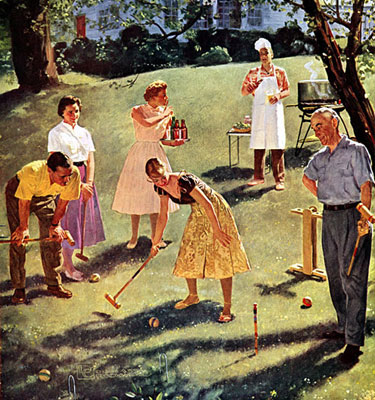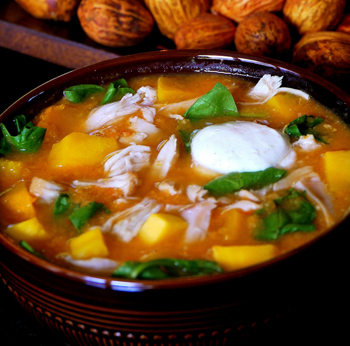 It rained here for the last three weekends. As a result, the Sunday farmers' market was nearly empty. (Southern Californians don't go out in the rain.) So, it's been just a few farmers, some die-hard vegetarians, and a handful of New England transplants.
It rained here for the last three weekends. As a result, the Sunday farmers' market was nearly empty. (Southern Californians don't go out in the rain.) So, it's been just a few farmers, some die-hard vegetarians, and a handful of New England transplants.
This all changed yesterday. It was the quintessential San Diego day - sunny, with a light breeze. You couldn't move at the farmers' market. People were clamoring for colorful rainbow carrots, luscious Meyer lemons, and tart pink grapefruit.
The biggest attraction was the exceptionally juicy, tangy blood oranges that beckoned market-goers with their ruby-colored flesh. One poor farmer handing out samples nearly got trampled on by a gaggle of Red Hats who were visiting. And there I was without my camera. Ugh.
So what's all the fuss about? Anthocyanin, the same chemical that makes blueberries blue and cranberries red, gives blood oranges their characteristic "bloody"color. It can range from bright ruby red to deep burgundy and has an exceptionally pleasing sweet-tart flavor unlike any other orange.
Winter
Winter
Brussels Sprouts on Botox

Not so at the cruciferous vegetables table. There lie the Brussels sprouts, kale, cabbages, broccoli, and cauliflower (of which only the funky Romanesco variety is getting any attention). These uncomely vegetables patiently wait for someone to come by and check them out. It is a long wait.
This past Sunday the Brussels sprouts were carelessly dumped in a lop-sided pile, causing stray runaway sprouts to keep rolling off the table's edge and onto the concrete. Inspired by Molly’s witty post at Orangette, I thought I would take on a challenge. A makeover for three undatable vegetables: Brussels sprouts, cauliflower, and broccoli. The make-up? Breadcrumbs.
Chipotle Chili Butternut Squash Soup is Hot
 I'm not exactly sure when it happened, but at some point in the last several years, ginger butternut squash soup became America's #1 vegetarian soup of choice.
I'm not exactly sure when it happened, but at some point in the last several years, ginger butternut squash soup became America's #1 vegetarian soup of choice.
Ginger butternut squash soup is everywhere. Google it, and you'll get hundreds of recipes (I stopped counting after the eighth full page load). Every vegetarian cookbook has a recipe for it. It's the go-to soup for Thanksgiving holidays and dinner parties, and 9 times out of 10, it's the only vegetarian soup available at cafeterias and supermarkets food courts. I've seen brawls break out in Trader Joe's as people frantically try to scoop up as many cartons of butternut squash soup as possible.
I understand the love. I made my first pot of ginger butternut squash soup about 15 years ago from a vegetarian cookbook I bought right after we moved to North Carolina. It was a revelation: creamy, refreshing, soothing. I have made that soup so many times, the recipe is etched in my brain along with my telephone number and birth date.
Homemade Chicken Noodle Soup
 I love soups, stews, chilies – one pot wonders that will fill you up and feed you for days! Often when I’ve been writing about food, having a food photoshoot for a book or magazine or discussing menus with clients, the last thing I want to do is go home and cook. Yet, cooking is my therapy too – being a foodie is a tangled web indeed.
I love soups, stews, chilies – one pot wonders that will fill you up and feed you for days! Often when I’ve been writing about food, having a food photoshoot for a book or magazine or discussing menus with clients, the last thing I want to do is go home and cook. Yet, cooking is my therapy too – being a foodie is a tangled web indeed.
My chicken noodle soup is simple. I think it is delicious (toot toot goes my own horn) and it cooks up fast and will feed pharaoh’s army – a highly desirable trait for a dish in my family! I also like that this recipe is basic enough to appeal to year round flavors. Of course, during the winter, I crave this warm soup with some leafy kale and carrots, but I’ve found that basil or lemon thyme are delightful additions in the summertime as are sage and rosemary in the fall and chervil in the spring.
There are two ways to make this soup – neither of which are right or wrong. There is the homemade version where you stew a hen, make your own stock, cut the kale and herbs from your garden etc etc etc and then there’s the quick and easy version – the latter I find myself preparing more often than the former! PTL (Praise The Lord for those not brought up in the Bible Belt) for store bought rotisserie chickens!
Farmer’s Note: This “recipe” is more of a read through, thus you can cook to your liking. Enjoy y’all!
Hearty Vegetarian Three Bean Chili
 I love hearty spicy chili, especially during the winter months. This one is quick to make with just basic ingredients and guaranteed to warm you up on a cold day.
I love hearty spicy chili, especially during the winter months. This one is quick to make with just basic ingredients and guaranteed to warm you up on a cold day.
The variety of beans – red kidney, black and pinto – gives the chili a nice “meaty” quality. I think it has a nice balance of heat, but you can add extra cayenne or a chopped jalapeño to add a little more “fire”.
More Articles ...
Welcome to the new One for the Table ...
Our Home Page will be different each time you arrive.
We're sure you'll find something to pique your interest...


